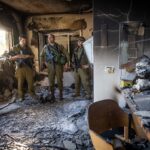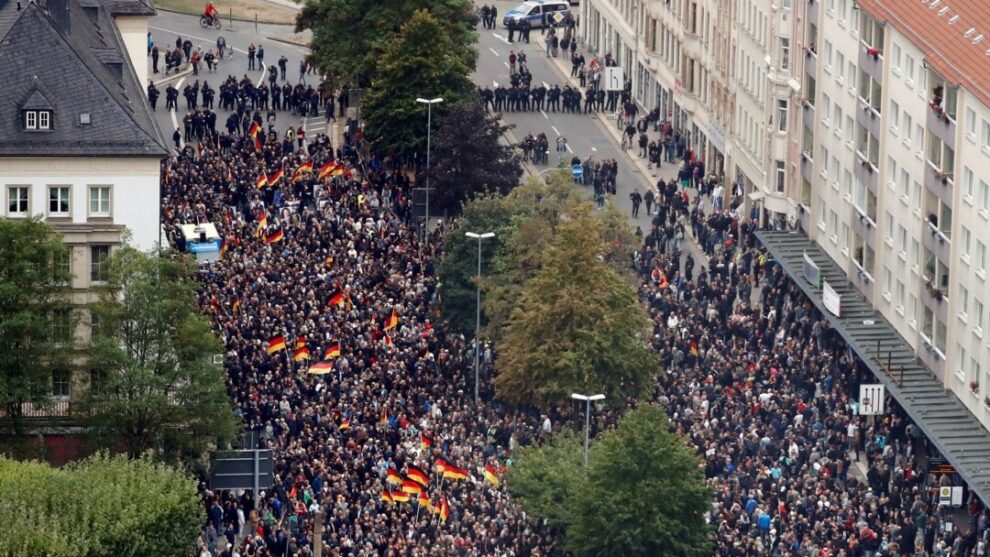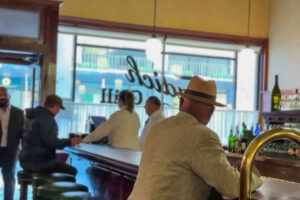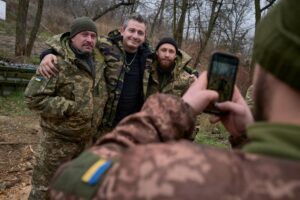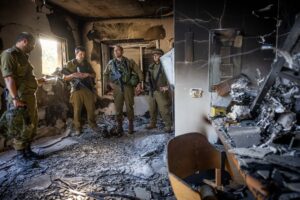The terrible events took place 32 years ago, Joe E* told DW, and he had tried hard to forget them. “When I received the court summons, it all came to the surface again,” he said.
He was called to testify in a case that is before a court now because there is no time limit for murder prosecutions in Germany. Since November 2022, the Higher Regional Court of Koblenz has been attempting to clarify what exactly happened in the early hours of September 19, 1991, in Saarlouis, a town of 35,000 in the tiny state of Saarland, in the very west of Germany.
At that time, one or more offenders poured gasoline on the wooden steps of an accommodation center for asylum applicants and set it alight.
The fire spread quickly through the former hotel. Living there at the time were people who had fled Ghana, Nigeria, Ivory Coast, Mauritania, Sudan and the Balkans. Samuel Kofi Yeboah, 27, from Ghana was one of them. He suffered an excruciating death.
Three loud explosions woke Joe E. that night — luckily, he said. “Otherwise perhaps I would also have died.” He went to the stairwell: “Then I saw smoke and flames — the whole wall was completely in flames.” Two young men from Nigeria suffered broken bones from jumping out the window. A French woman who was a guest in the house cried as she described to the court 32 years later how people were screaming and jumping out the windows.
Joe E. recalled how they suddenly heard calls for help from Samuel Yeboah, who lived on the top floor: “He called in his language, I’m dying, I’m dying.” He was surrounded by flames, the others could not help him. He fell silent. Firefighters rescued him with severe burns to his whole body. He still tried to speak with them.
The young man from Ghana died three hours later in hospital. Samuel Yeboah was a very lovable person, Joe E. recalls: He boxed, played football, and had many German friends.
Signals to victims and perpetrators
The police began interrogating survivors on the night of the fire. They investigated the possibility of drug dealing and organized crime. It took days for them to question members of the neo-Nazi-skinhead scene in Saarlouis and they quickly closed this line of enquiry. In 1992, after almost a year, they shut the investigation.
A month before the fire at this accommodation facility, there was an arson attack on another facility for refugees and migrants in Saarlouis. Joe E., who knew people there, said that the inhabitants of both centers had received threatening letters reading: “Go back to your ‘jungle’ or you will all be killed.” A police officer who was investigating the case in 1991 told the Koblenz trial that there had been no “xenophobic attacks” in Saarlouis.
“You got the impression that the police treated it as if it were a childish prank. But a person lost his life, others have lifelong damage,” said Heike Kleffner from the Association of Counseling Centers for Victims of Right-Wing, Racist and Antisemitic Violence in Germany, or VBRG.
“This lack of interest from the law enforcement authorities in the 1990s signaled to the victims, ‘your life is worth nothing from our perspective.’ The perpetrators and their sympathizers got the message, ‘you will get away with this’,” Kleffner said.
Confession at a barbecue
The fact that it has come to new investigations and Peter S.** being put on trial is due to a witness. “That was me and they have never caught me,” — these are the words the defendant is accused of saying to a witness at a barbeqcue in 2007, referring to the arson in Saarlouis. When the witness learned in 2019 that a man had been killed in the attack, she reported it to police.
Unlike in 1991, public prosecutors and police followed up this tip with intensive investigations into the right-wing scene in Saarlouis, involving searches, surveillance measures and many interviews with witnesses. The Office of the Federal Prosecutor (GBA) took over the case and laid charges.
For the past 10 months, the case has been before the courts under the leadership of presiding Judge Konrad Leitges. “We will not give up, we will leave no stone unturned,” he told a witness.
It was only after the accused was arrested in April 2022 that the Saarland police chief apologized for deficiencies in the police work.
The 1991 report from the Federal Office for the Protection of the Constitution, Germany’s domestic intelligence agency, classified the deadly attack as an act of violence with a right-wing extremist background. It was one of many attacks involving arson or explosives in Saarland. Those affected who continue to live in the state may still not feel safe today, Kleffner said.
More than 30 years after the arson attack, Joe E. said he was glad that the case had been brought to trial. “The truth must come to light.” As a witness in court, he sat a short distance away from the defendant, Peter S. who at the time of the attack was part of the neo-Nazi-skinhead scene in Saarlouis. Two other suspects are also currently being investigated. The man, who was a ringleader in Saarlouis’ right-wing extremist scene, has been imprisoned on remand since June 2023.
Federal prosecutors accuse the defendant of murder, attempted murder, and arson, motivated by national socialist and racist beliefs. During the trial, a photo of him in an SS uniform with a swastika armband was shown. Initially, the defense had said he had been asleep on the night of the fire.
After the court signaled that he could expect a conviction, Peter S. clarified via his lawyer that he was there when another man from the skinhead scene poured the gasoline and lit the flames at the asylum seekers’ home.
Hundreds of right-wing motivated arson attacks
Joe E. recalls the night of the fire. “I am still suffering today because we did not receive any help,” Joe E. says. He is traumatized and has severe depression. “It has shaped my life.”
For more than 30 years, Joe E. heard nothing from the Saarland authorities — apart from a deportation notice which he received shortly after the attack, as did at least one other survivor. It was only this year that he received a letter from Saarland’s victim protection officer in which she offered support. Seven survivors could no longer be found.
In the years following German reunification, many accommodation facilities for refugees were targeted in arson attacks. The prosecution spoke of a “pogrom-like atmosphere” in light of the nationwide right-wing extremist riots against asylum seekers. Police and domestic intelligence officials registered at least 1,250 right-wing arson attacks between 1990 and 1994, said Kleffner.
Criminologists estimate that 20% of those cases have been resolved at most.
It took until the 32-year anniversary for the city of Saarlouis to speak of a racist attack. Three organizations kept the memory of Samuel Yeboah alive over the decades: The Saarland Refugee Council (SFR), Antifaschistische Aktion Saar (Antifascist Action Saar) and Aktion 3. Welt Saar (Action 3rd World Saar). They demanded that a memorial plaque for Samuel Yeboah be placed in a prominent location in the city.
Political responsibility
In June 2023, Anke Rehlinger of the center-left Social Democrats (SPD) was the first state premier of Saarland to acknowledge, “it was a racially motivated crime.” Addressing the survivors, she said: “On behalf of the Saarland state government, I apologize to the victims and relatives of the arson attack in Saarlouis for the failures of that time.”
She announced a compensation fund for the victims of severe acts of violence. In October, the political investigation of the murder of Samuel Yeboah and other attacks is due to begin.
The trial could also act as a signal to the thousands of survivors of racist and right-wing violence of the 1990s. This example could show them that the authorities now – unlike back then — take their protection seriously.
“For all these years, I thought that I had been forgotten,” Joe E. said. Now he hopes, also for his friend Samuel Yeboah, “that we receive justice, that he did not die for nothing.”
The verdict is expected in October.
Source : DW



